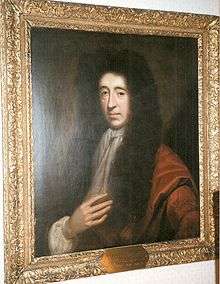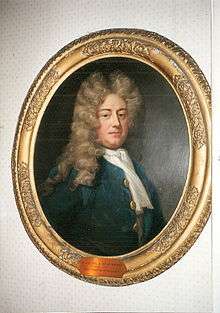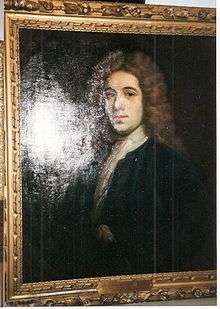Evelyn baronets
There have been three Evelyn Baronetcies, two in the Baronetage of England and one in the Baronetage of Great Britain. These are shown individually below in order of creation. The three families are closely related and made their money out of gunpowder.[1]

Sir John Evelyn of Godstone, 1st & last Bt

Sir John Evelyn of Wotton 1st Bt

Sir John Evelyn of Wotton 2nd Bt MP
Evelyn of Godstone, Surrey
Created in the Baronetage of England 29 May 1660 for
- Sir John Evelyn, 1st Baronet (12 March 1633 – 10 August 1671) High Sheriff of Surrey 1666
- Extinct on his death
Evelyn of Long Ditton, Surrey
Created in the Baronetage of England 17 February 1683 for
- Sir Edward Evelyn, 1st Baronet MP for Surrey 1685–1687 (25 January 1626 – 3 May 1692)
- Extinct on his death
Evelyn of Wotton, Surrey
Created in the Baronetage of Great Britain on 6 August 1713[2] for:
- Sir John Evelyn, 1st Baronet (1 March 1682 – 15 July 1763), MP for Helston 1708–1710, Joint Postmaster General 1708–1715, grandson of John Evelyn, the diarist. He was succeeded by his son:
- Sir John Evelyn, 2nd Baronet (24 August 1706 – 11 June 1767), MP for Helston 1727–1741 and 1747–1767 and Penryn 1741–1747. He was succeeded by his son:
- Sir Frederick Evelyn, 3rd Baronet (1734 – 1 April 1812). On his death, the baronetcy passed to his cousin:
- Sir John Evelyn, 4th Baronet (c. 1758 – 14 May 1833). When he killed a postman he was declared of unsound mind (28 July 1795) and spent the rest of his life in prison. He was succeeded by his brother:
- Sir Hugh Evelyn, 5th Baronet (31 January 1769 – 28 August 1848). He spent eighteen years in prison for a debt of £30. :The baronetcy became extinct on the death of the fifth baronet.[3]
gollark: https://images-ext-2.discordapp.net/external/bTwfpc26DYSllq58ZO5T0b23QBtM5Shmnjga0z2hKig/https/media.discordapp.net/attachments/487976605340139521/960852541862723624/3FD4ED2A-17DD-40E7-980C-A37BEB6E9DC9.png
gollark: Due to inevitable loss of bees to accidents we may lose all bees by 2024 or later or earlier.
gollark: Without this, bees are not a renewable resource and we may face a "peak bee" crisis.
gollark: @all staff ever Please fix markets being unable to sell queen bees.
gollark: Why would it be that? That's longer and thus impossible by Occam's razor.
References
- Burke, John; Burke, Sir Bernard; Burke, Bernard (1841). A Genealogical and Heraldic History of the Extinct and Dormant Baronetcies of England, Ireland and Scotland. p. 188.
- "No. 5139". The London Gazette. 18 July 1713. p. 2.
- Cokayne, George Edward (1906) Complete Baronetage. Volume V. Exeter: W. Pollard & Co. LCCN 06-23564. p. 17
External links
This article is issued from Wikipedia. The text is licensed under Creative Commons - Attribution - Sharealike. Additional terms may apply for the media files.